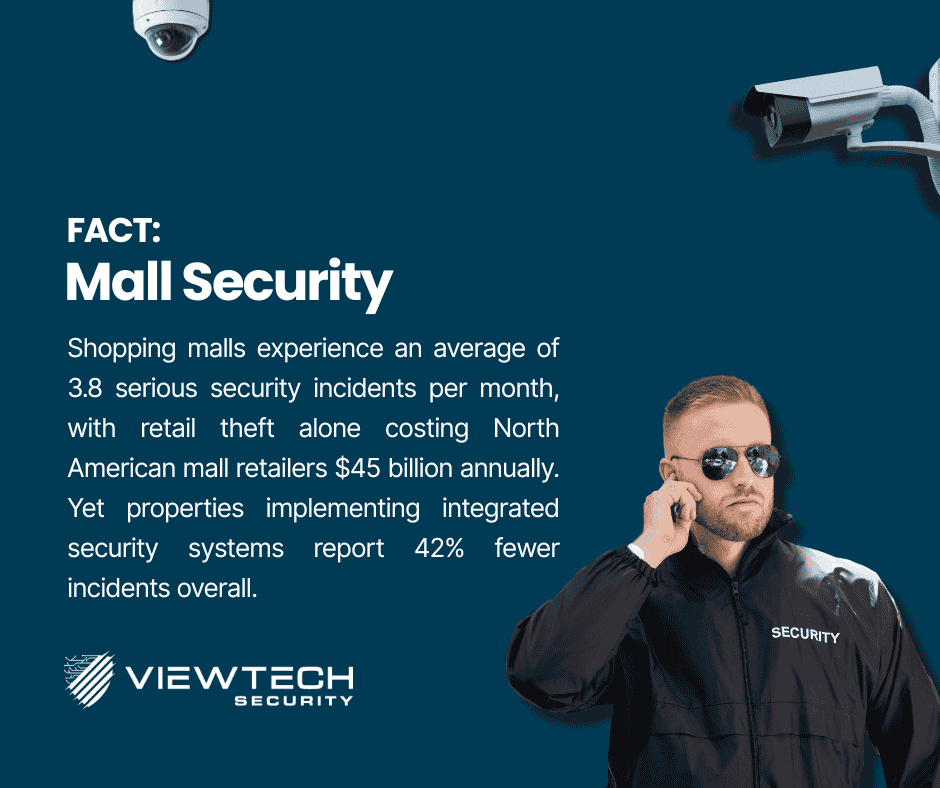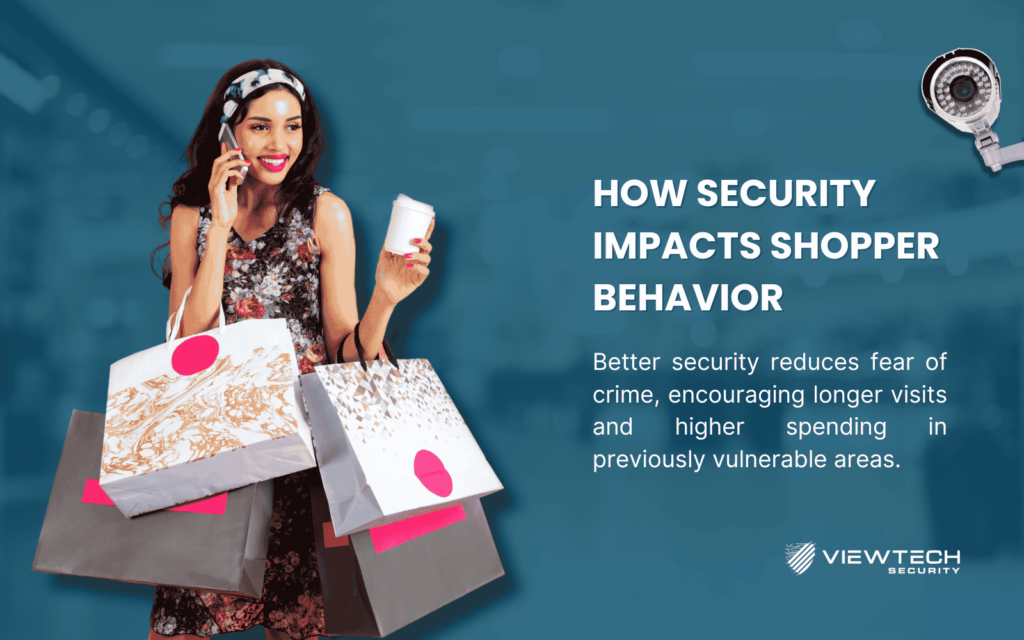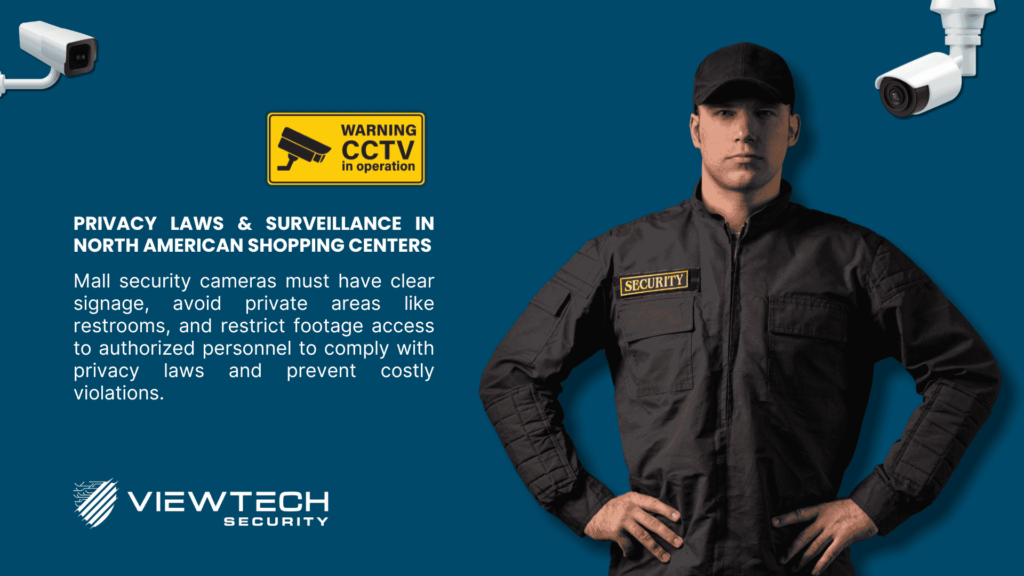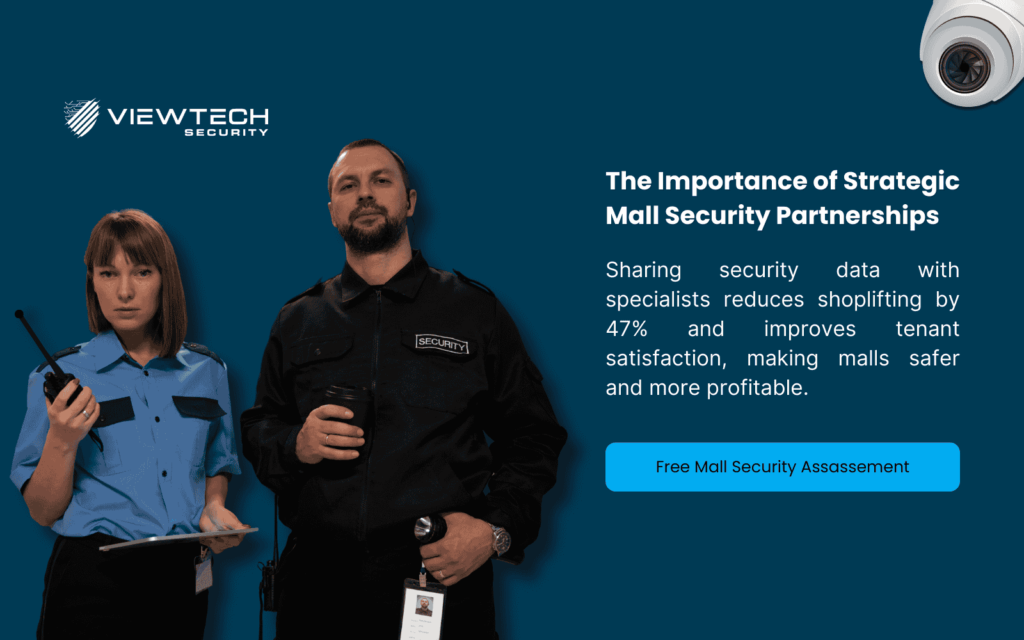This guide examines proven mall security strategies backed by industry data, covering essential components from AI-powered surveillance to coordinated response protocols. We explore technology integration methods, provide implementation case studies with measurable ROI, and offer a framework for security investment decisions specifically for mall executives and property managers.
The Evolving Security for Shopping Centers
Recent industry data reveals disturbing trends for mall operators: organized retail crime incidents increased 26.5% in 2023, while security-related liability claims against shopping centers rose 34% over the past three years. The financial impact extends beyond direct losses; properties with visible security issues experience 18% lower occupancy rates and 23% reduced visitor dwell time.

For mall owners and operators, these figures translate to concrete business challenges:
| Security Vulnerability | Direct Business Impact | Industry Average Loss |
| Organized retail theft | Tenant dissatisfaction and turnover | $287,000 per mall annually |
| Parking area crime | Reduced visitor frequency and evening traffic | 22% decrease in evening sales |
| Emergency incident mismanagement | Liability claims and reputation damage | $430,000 per major incident |
| Interior common area disturbances | Decreased dwell time and per-visit spending | 17% reduction in food court revenue |
A shopping center in Toronto demonstrated how strategic security upgrades deliver measurable returns. After implementing an integrated security ecosystem in 2022, the property reported:
- 37% reduction in reported theft incidents
- 42% decrease in parking area incidents
- 28% improvement in tenant satisfaction scores
- 19% increase in evening visitor traffic
Core Mall Security Components
Modern mall security systems leverage multiple technologies working in concert. Industry performance data shows which components deliver the strongest ROI:
1. AI-Enhanced Video Surveillance
Standard surveillance has evolved into intelligent monitoring systems that actively identify threats before they escalate. Implementation data shows:
- Malls using AI-powered analytics identify suspicious behavior patterns 7-12 minutes earlier than traditional systems
- Facial recognition integration enables identification of known offenders with 94.3% accuracy
- Heat mapping capabilities provide actionable data on shopper movements, improving both security and marketing insights
- Remote monitoring reduces security staffing requirements by 23% while improving coverage
These systems prove particularly effective for monitoring high-risk areas like parking structures, service corridors, warehouses, and food courts, where traditional surveillance often proves inadequate.
2. Multi-Layered Access Control
Modern access management extends far beyond basic door locks:
- Credential-based systems reduce unauthorized access incidents by 64% compared to traditional key systems
- Integration with scheduling systems ensures vendor access only during approved timeframes
- After-hours delivery management systems reduce overnight security incidents by 47%
- Emergency lockdown capabilities can secure sensitive areas within 8.2 seconds of activation
A Vancouver Shopping Mall Centre implemented zone-based access control in 2023, resulting in a 56% reduction in back-of-house unauthorized entries and eliminating after-hours service corridor breaches entirely.
3. Data-Driven Security Personnel Deployment
While technology provides the foundation, strategic deployment of security staff remains essential:
- Properties using data analytics to guide security patrols report 32% faster response times
- Mobile-equipped officers resolve incidents 41% more efficiently than those without digital tools
- Guard stations positioned based on heat mapping data intercept potential incidents 27% more effectively
- Cross-trained staff who combine security and customer service functions increase positive visitor interactions by 215%
The most effective mall security teams now operate as information hubs rather than simply providing visible presence. When equipped with real-time data and communication tools, these professionals transform from reactive responders to proactive threat prevention specialists.
4. Integrated Communications Infrastructure
Communication failures account for 63% of mall security incident escalations. Modern solutions address this through:
- Mass notification systems capable of reaching 99.7% of mall occupants within 45 seconds
- Direct connections to emergency services reducing response times by 4.7 minutes on average
- Staff communication platforms enabling immediate alert sharing across all security personnel
- Tenant notification protocols that warn retailers of emerging situations
When a shopping centre in Toronto implemented an integrated communication platform in 2022, emergency response coordination improved by 37%, and critical information dissemination speed increased by 68%.
Implementation Framework: The Security Decision Matrix
Mall executives should evaluate security investments against this performance-based framework:
- Risk Assessment: Conduct professional vulnerability analysis identifying specific threat probabilities and potential impacts
- Technology Integration Planning: Prioritize systems that share data and function as a unified ecosystem rather than standalone solutions
- ROI Calculation: Measure security investments against:
- Insurance premium reductions (average 12-18%)
- Liability claim avoidance
- Tenant retention improvements
- Customer traffic increases in previously vulnerable areas
- Phased Implementation: Deploy in order of risk priority:
- Phase 1: Core surveillance and communication infrastructure
- Phase 2: Access control and intrusion detection
- Phase 3: Analytics and intelligence gathering
- Phase 4: Advanced integration and automation
- Performance Measurement: Establish baseline metrics before implementation and track improvement in:
- Incident frequency and severity
- Response time averages
- Customer perception scores
- Tenant satisfaction ratings

Schedule a comprehensive security assessment with ViewTech’s mall security specialists to identify your property’s specific vulnerabilities and opportunities
Case Study: West Edmonton Mall Security Transformation
One of North America’s largest shopping centers faced growing security challenges despite an extensive traditional security presence. Their systematic approach included:
- Installing 420 AI-enabled cameras with behavior analysis capabilities
- Implementing unified access control across 145 service entry points
- Deploying mobile-equipped security teams guided by real-time analytics
- Creating a central security operations center with direct emergency service connections
- Establishing a collaborative intelligence network with 382 retail tenants
After 18 months, the measurable outcomes included:
- 51% reduction in retail shrink incidents
- 38% decrease in parking area crime reports
- 42% improvement in emergency response times
- 27% increase in evening shopping hours visitor counts
- 19% growth in tenant satisfaction scores
- 7.3% reduction in insurance premiums
Emerging Technologies Reshaping Mall Security
Forward-thinking mall operators are adopting these proven innovations:
- Predictive Analytics: Systems identifying potential security issues 15-30 minutes before visible warning signs appear
- Automated License Plate Recognition: Parking systems that identify vehicles with history of security incidents, reducing parking area crime by 36%
- Unified Building Management: Platforms combining security, HVAC, and operations data to identify unusual patterns
- Distributed Acoustic Sensors: Systems detecting breakage, unauthorized entry, or disturbances through sound pattern analysis
- Digital Twin Technology: Creating virtual replicas of properties for security scenario planning and response training
Canadian Regulatory Compliance
For Canadian mall owners, security implementation must address specific regulatory requirements that vary by province and municipality. Mall security planning that ignores these regulations risks significant penalties and liability exposure.
FACT: 73% of Canadian malls faced at least one compliance-related issue in the past 24 months, with average remediation costs exceeding $127,000 per property.
| Regulatory Area | Key Requirements | Non-Compliance Penalties | Implementation Considerations |
| Provincial Privacy Laws | Camera placement notification, data storage limitations, access restrictions | $10,000-$100,000 depending on province | Video surveillance systems must include proper signage and restricted monitoring zones |
| Security Personnel Licensing | Provincial guard licensing, training certification, background checks | Business license suspension, individual guard penalties | Staff must maintain current credentials; verification systems should be automated |
| Emergency Response Requirements | Documented protocols, staff training, coordination with local services | Liability multiplication in incidents, potential criminal charges | Intercom systems must connect to emergency services with redundant backups |
| Fire Safety Coordination | Integration with fire systems, evacuation routes, staff responsibilities | Insurance coverage limitations, code violation fines | Security systems must not impede emergency egress while maintaining normal access control |
| Accessibility Compliance | Security measures must accommodate persons with disabilities | Human rights complaints, remediation orders | Access control systems must provide equivalent protection without creating barriers |
A Yorkville Mall in Toronto achieved 100% compliance across all regulatory areas through implementation of ViewTech’s integrated security management system, which automatically tracks regulatory requirements and documentation. Their compliance dashboard provides real-time visibility into training status, certification expiration dates, and required security protocols.

“Regulatory compliance was previously our most significant mall security challenge,” notes S.C., Operations Director at a Yorkville Mall. “Implementing a system that automates compliance tracking reduced our administrative burden by 62% while eliminating compliance gaps.”
The most effective approach combines:
- Centralized compliance documentation
- Automated credential tracking
- Regulatory update monitoring
- Staff training management
- Audit-ready reporting capabilities
Cost Optimization Strategies
Canadian mall operators face increasing security costs amid narrowing profit margins. Industry data reveals strategic approaches that maximize protection while controlling expenditures.
FACT: Malls implementing data-driven security resource allocation report 27% lower total security costs while achieving 34% better incident prevention rates compared to properties using traditional security models.
Security Budget Allocation Framework
| Security Component | Traditional Allocation % | Optimized Allocation % | Performance Improvement | Implementation Priority |
| Physical Guards | 68% | 42% | -26% cost, +17% effectiveness | Strategic positioning based on analytics |
| Video Surveillance | 14% | 23% | +64% coverage, +41% incident detection | AI-powered monitoring with behavior analysis |
| Access Control | 9% | 15% | +72% unauthorized entry prevention | Credential-based zoned protection systems |
| Emergency Systems | 6% | 12% | +38% response time improvement | Integrated communication platforms |
| Intelligence & Analytics | 3% | 8% | +213% predictive capability | Data aggregation and pattern recognition |
A major property management company’s Toronto properties demonstrated this optimization approach by transitioning from a guard-heavy model to a technology-centered strategy. Their security cost per square foot decreased by 19.7% while incident prevention improved by 28.3% year-over-year.
Key cost-optimization strategies include:
- Remote Monitoring Integration Canadian malls implementing live video monitoring services report 31% lower overnight security costs while improving coverage by 47%. These systems enable security professionals to monitor multiple locations simultaneously from centralized monitoring centers.
- Guard Deployment Optimization Using heat mapping and predictive analytics to position security personnel reduces required headcount by 23% while improving response times by 41%. The Mall of Canada (Mississauga) reduced security staff by 7 full-time positions while improving incident response metrics across all categories.
- Technology Lifecycle Planning Canadian properties implementing phased security technology upgrades report 34% lower total costs compared to reactive replacement approaches. Strategic planning enables integration of new components while maximizing the useful life of existing systems.
- Vendor Consolidation Shopping centers working with integrated security providers like ViewTech for custom solutions report 28% lower maintenance costs and 42% fewer system integration issues compared to multi-vendor approaches.
- Insurance Premium Offset Documented security improvements yield insurance premium reductions averaging 12-18% for Canadian properties, effectively subsidizing 31-47% of annual security technology investments.
Security Integration with Consumer Experience
Modern mall security extends beyond traditional protection to enhance overall shopping experiences, creating direct revenue benefits for property owners and retailers.
FACT: Shopping centers that positioned security as an experience enhancement rather than simply a loss prevention function reported 27% higher visitor satisfaction scores and 19% increased per-visit spending.
Security-Experience Integration Points
| Mall Security Component | Consumer Experience Benefit | Measurable Business Impact | Implementation Approach |
| Digital Wayfinding with Security Integration | Real-time crowding avoidance, parking guidance | 23% increased cross-mall shopping, 17% longer visits | Connect security sensors with shopper-facing apps |
| Secure Parcel Storage/Pickup Points | Hands-free shopping, theft prevention | 34% higher per-visit spending, 41% improved shopper convenience ratings | Integrate access control with retail fulfillment systems |
| Child Safety Monitoring | Peace of mind for family shoppers | 28% longer family visit duration, 39% increased food court revenue from families | RFID-based family tracking with automation integration |
| Weatherproof Pick-up Zones | Protected, monitored outside collection | 47% increase in retailer participation in omnichannel programs | Surveillance-covered, controlled access exterior spaces |
| VIP Security Services | Premium shopper offerings, personal assistance | 67% higher spending among enrolled customers | Special access areas, dedicated assistance, premium parking |
A prominent shopping center in Mississauga implemented a connected security experience that transformed their mall security from a cost center to a competitive advantage. Their “ShopSafe+” program integrated security features with consumer-facing benefits:
- Secure family zones with dedicated monitoring
- VIP shopping services with personal security escorts for high-value shoppers
- Weather-protected pickup zones with security monitoring
- Premium parking with license plate recognition and reserved spaces
The program generated:
- 19% increase in family shopper visit frequency
- 27% higher per-visit spending among program participants
- 42% improvement in perceived safety ratings
- 23% growth in retailer satisfaction scores

Integration Technology Framework
The foundation of connected mall security experiences relies on integration across previously separate systems:
- Unified Data Platform Successful implementations connect security data with consumer analytics, creating actionable insights for both protection and marketing teams. CF Market Mall (Calgary) unified their systems through ViewTech’s custom solutions platform, enabling real-time decision-making across departments.
- Mobile Security-Experience Apps Progressive malls develop shopper-facing applications that transform security features into consumer benefits. West Edmonton Mall’s app includes parking guidance based on security sensors, crowd density notifications derived from surveillance analytics, and security assistance request features.
- Experience Control Centers Leaders in this approach establish unified monitoring facilities where security and customer experience teams work collaboratively. Toronto’s Scarborough Town Centre reported 37% faster security response and 42% improved visitor satisfaction after implementing their integrated command center.
- Retailer Integration Protocols The most effective mall security programs establish data-sharing frameworks with tenant security systems. This coordinated approach resulted in 47% improved shoplifting prevention at Edmonton’s Kingsway Mall through their retailer security alliance program.
- Visitor Recognition Systems Advanced properties implement opt-in loyalty programs integrated with security recognition systems. Pacific Centre’s “Preferred Shopper” program combines frequent visitor benefits with personalized security services, resulting in 53% increased visit frequency among enrolled customers.
“The integration of mall security systems with consumer experience technology represents the future of shopping center operations,” explains a senior technology executive at a leading property management firm. “Our properties implementing this approach show consistently stronger financial performance while maintaining superior security metrics.“
The Business Case for Advanced Mall Security
The data is clear: shopping centers that invest strategically in integrated security solutions experience measurable business improvements beyond basic loss prevention:
- Average 23% increase in visitor dwell time
- 17% improvement in tenant retention rates
- 12-18% reduction in insurance costs
- 42% decrease in security-related liability claims
- 31% improvement in evening shopping hour traffic
For mall executives, the question isn’t whether comprehensive security measures deliver ROI, but rather which combination of solutions best addresses their specific property’s risk profile and business objectives.ViewTech designs customized security solutions for shopping centers across Canada, incorporating advanced video surveillance, access control, and integrated monitoring. Contact our team today at https://www.viewtech.ca/contacts/ to discuss how our proven approach can strengthen both your security posture and business performance.

